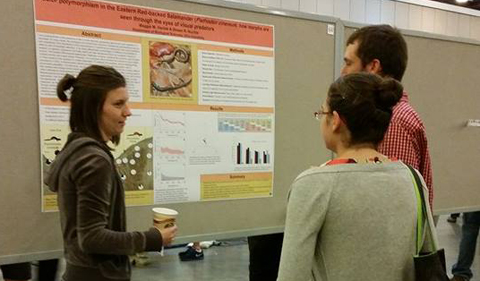 Biological Sciences graduate student Maggie Hantak presented a paper on “Color Polymorphism in the Eastern Red-backed Salamander (Plethodon cinereus): How Morphs are Seen through the Eyes of Visual Predators” at the 2014 Joint Meeting of Ichthyologists and Herpetologists July 30 to Aug. 4 in Chattanooga, TN.
Biological Sciences graduate student Maggie Hantak presented a paper on “Color Polymorphism in the Eastern Red-backed Salamander (Plethodon cinereus): How Morphs are Seen through the Eyes of Visual Predators” at the 2014 Joint Meeting of Ichthyologists and Herpetologists July 30 to Aug. 4 in Chattanooga, TN.
Her co-author was Dr. Shawn Kuchta, Assistant Professor of Biological Sciences at Ohio University.
Abstract: Color polymorphism is an example of intraspecific morphological diversity within and between populations. Differing coloration of morphs may result in divergent interactions with visual predators. Organisms that are able to blend into their background (camouflage) more efficiently have a better chance of survival. The Eastern Red-backed Salamander, Plethodon cinereus, contains two common color morphs, a striped morph and an all-black ‘lead’ morph. Presently, it is not known if one of these morphs is better camouflaged in their natural habitat. To address this question, we are studying three populations in Ohio: a monomorphic striped population, a monomorphic lead population, and a polymorphic population. For this study, I am gathering data across seasons, light conditions, and habitats. A spectrometer is being used to collect reflectance measurements from color patches, providing measures of brightness, hue and chroma. Measurements are being collected from five patches on each salamander, as well as random samples of color throughout the habitat. Ambient light from each location is also being measured, as the quality of available light impacts perceived color. This color data will then be analyzed using mathematical models of the avian and mammal visual system to calculate relative contrast, and thereby quantify how well each morph blends into the background. This study will provide essential data for evaluating what evolutionary and ecological dynamics are involved in the maintenance of the color polymorphism in P. cinereus.




















Comments